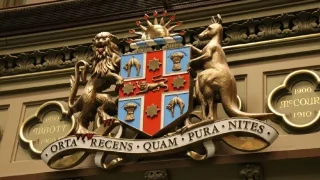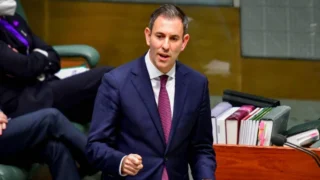

Tom Switzer’s chapter contribution, “A new pathway to prosperity,” in Harry Stutchbury’s (edited) Markets & Prosperity (Connor Court publishing, 2023), pp 215-225
Since federation, the economic governance of Australia can be conveniently divided into three contrasting periods. Phase one, which featured industry protection and centralised wage determination, lasted from 1901 to 1983. During these years, the state was dominant in almost every corner of life and the economy was characterised by periodic crises triggered by external shocks. From Edmund Barton to Malcolm Fraser, every prime minister accepted the power of the state to manage the economy.
What the distinguished journalist Paul Kelly has called “the Australian Settlement” began to fray in the 1970s and collapsed in the mid-1980s when we experienced the currency and balance-of-payments crises. Australia, as then-treasurer Paul Keating warned, could become a “banana republic.”
Australia was only saved from this fate by Bob Hawke’s Labor government. Showing political courage, he created a new economic orthodoxy, which liberated market forces, privatised state entities and slashed import tariffs. It was a Nixon-in-China moment: when a political leader defies expectations by doing something that would anger his supporters if taken by someone without his credentials. In this case, the former union leader upset Labor’s old socialist guard while winning support from his conservative opponents, such as John Howard.
The result was two decades of productivity-enhancing reform and, as a consequence, almost 30 years of growth with low inflation, low unemployment and, according to the Productivity Commission in 2018, no great widening in inequality. In real terms, national income per capita from the early 1990s to the peak of the resources boom two decades later increased by two thirds.
Tragically, this second phase of economic governance ended during the global financial crisis of 2008-09. “Neoliberalism” had come to an end, declared Kevin Rudd, social democracy would save global capitalism and there was a renewal of the long-lapsed faith in the power of the state. Ever since, Labor and Coalition governments settled into what the Australian Financial Review calls “the complacency of prosperity.” Canberra rested on the windfall of the China-fuelled resources development boom while it failed to curtail runaway spending projects (most notably National Disability Insurance Scheme, Gonski school funding, child care, aged care, public hospitals). During this era, the monetarist, free-market ideas that once defined liberal and conservative governance in Australia, the UK and the US had been largely abandoned.
Even the right-of-centre governments of prime ministers Tony Abbott, Malcolm Turnbull and Scott Morrison embraced the political left’s economic credentials as interventionists and big spenders. Borrowing was at astronomical levels. Incentive-sharpening reforms in tax and industrial relations to drive productivity had been shelved. At the same time, a debt-funded modern entitlement culture had taken hold, now tinged with the politics of identity and inclusion.
During this era, it’s been widely assumed that virtually every problem confronting the Australian people is an excuse for action by the federal government. The result has been productivity slowdown, wage stagnation and $1.2 trillion national government debt as the growth of government spending continues.
Australians have become used to relatively benign economic conditions stretching over the decades. But those days are over. With the Ukraine crisis, the global supply-chain disruption, the global energy shock, the fears of stagflation and the more dangerous geopolitical outlook, we have entered a new and dangerous environment. And although Australia’s starting point appears better than much of the rest of the world — after all, inflation and unemployment are lower here — a lot of Australians could nurse losses in jobs, businesses and hopes and dreams.
What now? What should define phase four of our economic governance? What sort of attitudes should economic policymakers cultivate? And, just as important, what should they be careful to reject? Here are a few suggestions.
First, defend and prosecute the economic-reform agenda.
Australia demonstrates the success of market economics: from the mid-1980s until the mid-2000s, reforms to deregulate the economy and to expand incentives to work and save led to sustainable economic growth and higher living standards for ordinary Australians. So much so that until the Covid recession, Australia had recorded its 28th uninterrupted year of economic growth — an OECD record. Far from leading to rampant inequality, sustained growth had delivered higher living standards across all income groups. Involuntary job loss as a proxy for job insecurity had dropped about 20 per cent from the early 2000s to about 2020. To this day, and notwithstanding union scaremongering, casualisation in the workplace has remained around the same level since the late-1990s — at about one quarter of the workforce.
None of this is to deny the genuine sense of public angst about the pace of socio-economic change. As Hansonism, Brexit, the Trump phenomenon and the wave of European populist insurgencies have shown, there are losers in technological change and globalisation. However, the forces that bred this creative destruction can’t be stopped. As Keating and Peter Costello often warned, a nation that shies away from structural reform and fiscal discipline won’t enjoy opportunity and prosperity for all.
Reform is a tough sell. But just think how the old Australia — the overregulated, highly unionised and inflation-prone country of the 1970s — would have coped during the global financial crisis of 2008-09 if previous leaders had not paid off our debt and implemented sound market policies to enable Australia to weather external shocks.
The lesson of economic reform is self-evident: jobs and growth are not created by state paternalistic power, but by private enterprises free to invest and innovate by being taxed and regulated less. If Canberra addressed the fundamentals of taxation, spending, regulations, education and the workplace, it would put in place the sound bases from which a long-lasting recovery is possible. Good policy to drive productivity and growth really does matter.
Bearing all this in mind, any reformist government should liberate what John Maynard Keynes called the economy’s “animal spirits” – that is, the passions and competitive instincts that are essential to economic growth. Slash costly regulations. Boost immigration to relieve inflationary worker shortages. Modernise our enterprise bargaining workplace system to drive wages through productivity gains without being eroded by inflation. Embrace an inflation-fighting wage restraint policy that helps avoid stagflation. Use the tax system to encourage entrepreneurship among younger Australians and help pay down the pandemic debt.
Second, vigorously oppose socialism.
More than 30 years ago, Francis Fukuyama posited the “end of history” thesis – that the collapse of Soviet Communism had heralded the triumph of Western liberal democracy and market capitalism. Today, though, socialism is resurgent across Australia and the Anglosphere. So much so that capitalism is regularly blamed for so much alleged doom and gloom: the supposed rampant inequality, economic insecurity, inter-generational debt, housing crisis and so on.
Millennials are lurching left in ways that could have profound consequences for Western politics. Since the beginning of the century, there has been a major shift in the political sentiments of young voters in Western democracies. As more people born between 1980 and 1996 have become eligible to vote, the political alignment of younger voters has become disconnected from the overall electorate. According to a Centre for Independent Studies/YouGov poll in 2018, 58 per cent of Australian millennials have a favourable view of socialism, with only 18 per cent having an unfavourable one. They believe government should have more control of the economy.
But there is no economy in history that has benefited from socialism. All economies that have enjoyed sustained growth and have broadened prosperity have done so through free trade and free markets; regulation is the enemy of prosperity, and prosperity is the only means of providing the public services that socialists are so fond of claiming they prize.
Lower tax rates and lower regulation are likely to bring higher growth and to help pay for some of the future education, health and welfare that society demands. Where do the critics expect to find the money in the post-Covid economy? You don’t tax a loss; you only tax a profit. Without profit – without capitalism – you cannot raise the revenue to provide for these public amenities. The more business succeeds, the more the tax receipts flow into the Commonwealth treasury.
Australians don’t think in terms of big or small government: as a practical people, we just want the state to act as a fair umpire that promotes individual freedom without creating an unacceptable level of insecurity. But there is also a long-run cost to dependency on the state, including an aversion to risk that boosts entrepreneurial spirit necessary for innovation and prosperity.
Third, proceed cautiously on decarbonising the economy.
It’s widely believed the world has resolved to reduce and eventually eliminate its dependency on fossil fuels and to step up its reliance on renewable energy. However, the timeframe most countries have set for this transformation is entirely unrealistic. As one of the world’s most distinguished energy analysts Daniel Yergin argues, the shift to a net-zero world “is likely to take longer, to be more expensive and to require more technical innovation than many now anticipate”.
The world depends on fossil fuels for about 80 per cent of its energy. And in the 2020s, government budgets promoting the energy transition will be constrained by the heavy debt burden accumulated in the wake of the coronavirus crisis.
Accepting that there is at present a difficulty in achieving targets of net zero emissions by 2050, the climate enthusiasts talk up the excitement of the technological challenge that the goal represents. They also claim that to take any other stand would risk affronting international opinion.
And yet as the West strives to cut its carbon emissions, the developing world – notably the two most populated countries on the planet, India and China – does not. Such countries account for 65 per cent of global emissions, and they do so not to spite the planet or to offend the “international opinion” that carries such weight, but to try to raise their own living standards as best they can. These are countries beset by poverty, under-achievement and, often, disease.
The fact is that renewables just aren’t up to the job of powering the world’s economies. Solar and wind power still provide just a tiny share of the world’s total energy. They also struggle to replicate the reliability of oil and gas: today’s best rechargeable batteries for renewables have only a fraction of the energy density of hydrocarbons from gas and oil; so until this problem is rectified, there will always be a place for gas and oil.
We are seeing, and will continue to see, the effect of the law of unintended consequences. The conventional wisdom is that the replacement of fossil fuels with renewables will lead to reliable and cheaper energy. However, reducing carbon energy has just reduced the supply of reliable and affordable energy, which means higher energy prices. Now, to reduce prices, governments are calling for more gas, coal and coal production.
Moreover, as former foreign minister Alexander Downer has argued: “How is it cheaper to have energy that has to be subsidised? If it has to be subsidised, by definition it must be more expensive. And the subsidies have to be paid for. If they’re not paid for through higher taxes, then they will be paid for through increased borrowing. The increased expenditure and borrowing will contribute to increased inflation and increased interest rates.”
Instead of the orgy of rhetoric designed to make noisy environmentalists feel smug, Western governments need to make proper contingency plans for their own energy supplies and tread carefully in their reliance upon renewables: even if that means using coal to power generators of electricity, or the renaissance of nuclear power to keep the world’s light on. And the developing world must have the same chance the developed one had, and make its prosperity as best it can.
One day, with market-driven technological breakthroughs, all this will be possible without using fossil fuels. But it just isn’t possible yet, and we should end the pretence it is, or will be any time soon.
Fourth, normalise monetary policy to break inflation.
In response to the inflation surge in 2022, central bankers and their defenders blame higher prices on Russia’s invasion of Ukraine and supply-chain bottlenecks that have disrupted the global production of goods. No doubt global factors in 2022 contributed to rising prices, especially food and energy. But it was the combination of vast federal spending and easy monetary policy in recent years that primarily set the scene for the emerging inflation crisis.
Until recently, the conventional wisdom held that, with interest rates around the developed world exceptionally low and likely to remain so for a long time, the heavy borrowing that had taken place in recent years could be cheaply financed. That helps explain why the Reserve Bank of Australia kept interest rates at near zero, even though Australia experienced a roaring economy and rapid job creation long after the Covid economic crisis had passed. The result of the extraordinarily loose monetary policy settings has been the surging inflation that has caught central banks and Keynesian economists by surprise.
The inflation surge has prompted a policy shift to tighter money: the RBA is now on the case, rightly raising interest rates; it will have to move faster in an economy that is still growing, but with less business and consumer confidence. Like other central banks, it has to find a way to reduce inflation without sending the economy into a sharp recession.
Fifth, repair the budget to help prevent fiscal policy from fuelling inflation and higher interest rates.
There is a widespread view that during the nine years of Coalition rule in Canberra (2013-22), the Abbott, Turnbull and Morrison governments slashed spending on crucial social services. In fact, for more than a decade, Labor and Coalition government spending on health and education as a percentage of GDP increased. And as my CIS colleague Robert Carling has pointed out, the program specific risks of higher spending in the fast growing areas of NDIS, Gonski schools, age-child-health care and now defence represent the largest threats to budget repair. Indeed, they account for about half the estimated total increase in federal spending over ten years from 2013-14.
But there is no such thing as a magic money tree – the belief that growth is natural, that budgets never need to be balanced or that money can be borrowed indefinitely to subsidise unlimited spending. The electorates currently so happy with free-spending budgets seem oblivious that the costs will continue to be paid by their grandchildren. But in situations such as this, it is not just the super-rich and wealthy who end up footing the tax bill: it is everyone.
For the moment, governments win popularity by engaging in this high-spending, nannying management of populations. In response, these populations seem to suggest they like having others decide for them not just what they do and how they do it, but also how to spend their money. Economic history ought to tell these governments — and those who think they are doing such a brilliant job — that the usual end result of periods of high taxation and high public spending is massive economic inefficiency, overregulation and suppressed prosperity.
The stimulus spending that led to rising debt might have helped Australia weather the Covid shock, but it was not a sound basis for long-lasting recovery, never mind the wasteful spending that distorts incentives and diverts resources from more productive uses. Without a broad reform agenda that sharpens incentives to create wealth, and without budget repair, future generations will pay for the high debt load with crippling taxation and a much-devalued currency. If the economy lacks robust and resilient foundations, it will become vulnerable to downturns, external crises or another black swan event.
The prosperity of the past three decades has made the Australian people detached – even complacent – about government. However, after a decade of quantitative easing and, in response to the Covid pandemic, massive fiscal stimulus, Canberra’s conventional policies have been exhausted. We are entering new and terrifying territory. This means that there will come a day when our political leaders and policymakers need to exercise spending restraint and put in place productivity-enhancing reforms to grow the economy and pay down the pandemic debt. If they don’t make the case for a classical liberal, market-oriented public-policy agenda, then the coming years could be grim beyond belief, with terrible consequences for each and every one of us.








